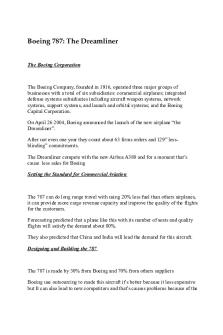Johnson Controls - Summary of the case PDF

| Title | Johnson Controls - Summary of the case |
|---|---|
| Course | Case Studies in Operations Management |
| Institution | California State University Los Angeles |
| Pages | 3 |
| File Size | 98.4 KB |
| File Type | |
| Total Downloads | 63 |
| Total Views | 145 |
Summary
Summary of the case ...
Description
JohnsonCont r ol s,Aut omot i veSyst emsGr oup:The Geor get own,Kent uckyPl ant
Johnson Controls, Inc. (JCI) JCI traced its roots to Warren Seymour Johnson, a professor at the State Normal School in Whitewater, Wisconsin, who received the first patent for a room thermostat in 1883 and founded the company two years later, in Milwaukee. The Automotive Systems Group (ASG) ASG emerged as the world’s largest independent supplier of automotive seating systems during the 1980s, ASG originated in the Automotive Seating Division of Hoover Universal, a company JCI acquired in 1985 JCI’s acquisition of Hoover fueled rapid growth of the automotive seating business. During the same year, 1985, JCI increased foam capacity and bought Ferro Manufacturing Corporation to expand seating mechanisms capabilities By the end of 1992, ASG, based in Plymouth, Michigan, employed 15,000 people in more than 65 engineering and manufacturing locations worldwide The Georgetown Plant The Georgetown facility was constructed in 1961, with John Daly as its first general manager. In September 1985, Daly, now vice chairman of JCI, declared to all his metal plant managers, including Buchenberger, “It’s time you guys go see Japanese seat suppliers.” A few weeks later, Buchenberger flew to Japan. No sooner had Buchenberger returned than Toyota announced that it was building its first US assembly plant—in Georgetown, Kentucky
Finally, Georgetown instituted Employee Involvement Teams (EIT), beginning by training hand-picked prospects. After investing more than $9 million, primarily in equipment to serve TMM, Georgetown began assembling seats for TMM in space created within the existing facility, but separated by new walls Georgetown received an award from TMM every year since TMM’s opening, the only supplier that could make this claim. With TMM, Georgetown’s sales increased by a factor of 10, and in 1992, TMM business accounted for 86% of the plant’s sales Current Operations In January 1993, about 500 people worked at Georgetown: 71% were direct employees, 16% indirect, and 13% salaried. Seat manufacturing involved four basic processes: metal stamping and welding, foam molding, cut and sew, and seat assembly. Metal Operations The 342 employees, over two or three shifts, involved in metal operations made 7.8 million seat frames each year Assembly Operations Over two shifts, 183 employees assembled—just-in-time—240,000 complete seat sets annually for TMM’s Camrys Finished seats were palletized (one car set/pallet) and rolled on the shipping line leading to a simulator Production Control Georgetown currently produced metal frames in-house, outsourcing mechanisms, foam pads, head rests, and trim covers. Every Thursday, TMM sent its production plan through EDI (electronic data interchange), which contained a firm order for the first two weeks out and a plan for an additional 11 weeks out. Because of prohibitive freight costs, JCI in some cases installed foam-making equipment in their seat assembly plants.
The “New” Plant Which seat component operation should control the plant became an issue within ASG, however. Eventually, John Barth, ASG’s head, decided to place this second Georgetown plant in the custody of the Toyota Business Unit. he latest plan for the new space called for allocating 80,000 square feet to brandnew foam operations, like those performed in Livermore PROBLEM AND RECOMMENDATION The problem was here that the simulator had been carried over from the 1987 model Camry, which was four inches narrower than the 1992 model and that could make fail all the production My recommendation here is to improve this system to fix this error and after that try to have deals with all the car company to make profit...
Similar Free PDFs

Summary of the case
- 6 Pages

BPL 5100 Johnson& Johnson case
- 3 Pages

BPL 5100 Johnson& Johnson case
- 5 Pages

Summary of the Dell Case
- 23 Pages

Boeing 787 - Summary of the case
- 2 Pages

Chapter 17 - The Data Controls
- 39 Pages

Lwso1 - Summary of court case
- 2 Pages

Summary of The Qur\'an
- 1 Pages
Popular Institutions
- Tinajero National High School - Annex
- Politeknik Caltex Riau
- Yokohama City University
- SGT University
- University of Al-Qadisiyah
- Divine Word College of Vigan
- Techniek College Rotterdam
- Universidade de Santiago
- Universiti Teknologi MARA Cawangan Johor Kampus Pasir Gudang
- Poltekkes Kemenkes Yogyakarta
- Baguio City National High School
- Colegio san marcos
- preparatoria uno
- Centro de Bachillerato Tecnológico Industrial y de Servicios No. 107
- Dalian Maritime University
- Quang Trung Secondary School
- Colegio Tecnológico en Informática
- Corporación Regional de Educación Superior
- Grupo CEDVA
- Dar Al Uloom University
- Centro de Estudios Preuniversitarios de la Universidad Nacional de Ingeniería
- 上智大学
- Aakash International School, Nuna Majara
- San Felipe Neri Catholic School
- Kang Chiao International School - New Taipei City
- Misamis Occidental National High School
- Institución Educativa Escuela Normal Juan Ladrilleros
- Kolehiyo ng Pantukan
- Batanes State College
- Instituto Continental
- Sekolah Menengah Kejuruan Kesehatan Kaltara (Tarakan)
- Colegio de La Inmaculada Concepcion - Cebu







